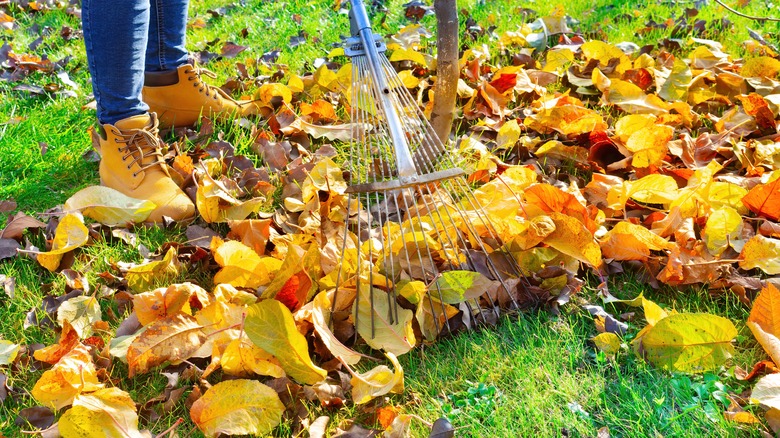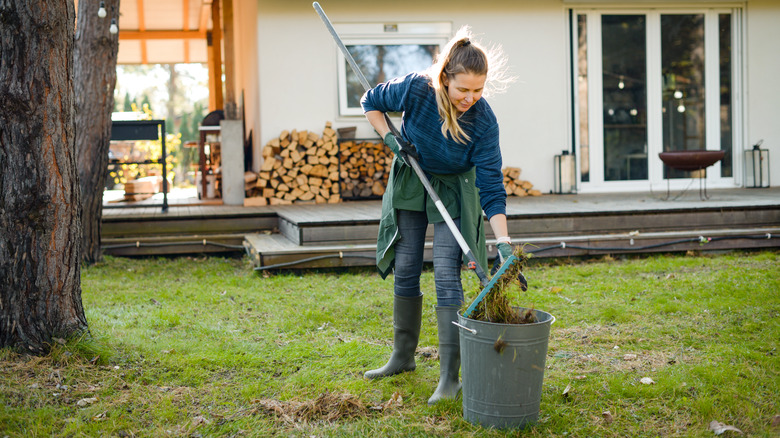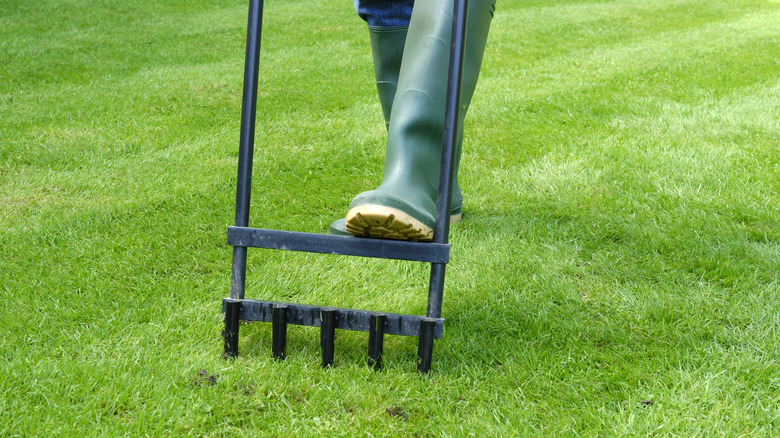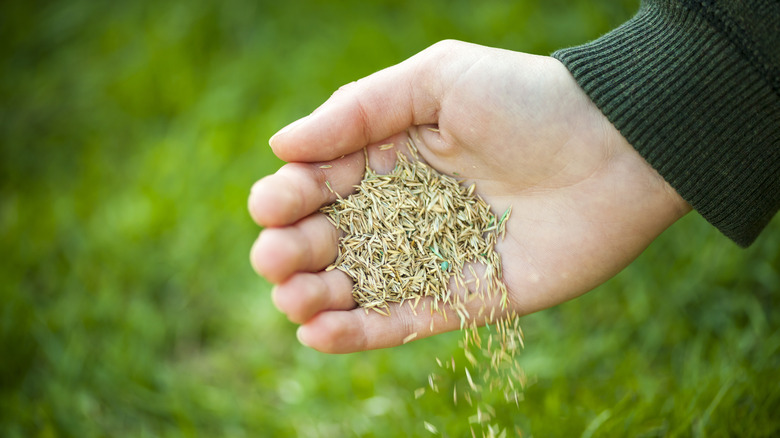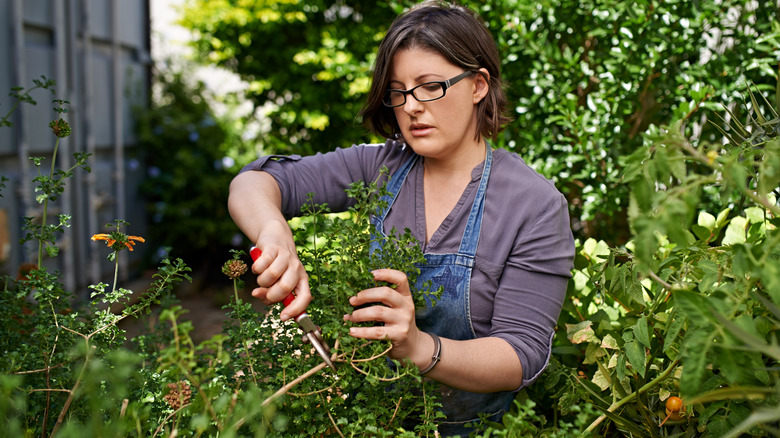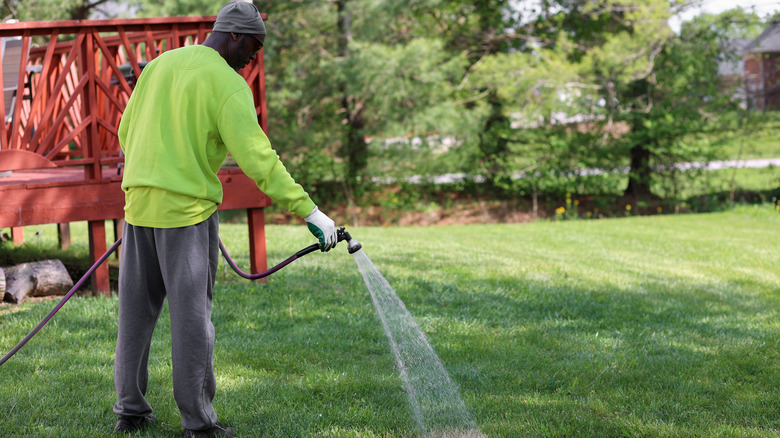Crucial Lawn Care Tasks For The Month Of October You Don't Want To Miss
For those of us who put in hours upon hours to keep our lawns in pristine condition, we know that the work doesn't end when summer does. While plants transition into dormancy for the winter, there are still a number of tasks we need to complete to help them adequately prepare for freezing weather and ensure that when spring comes back around, they emerge healthy and happy. Going into October and entering the autumn season, you won't want to miss any of the essential work needed to allow your lawn and garden to have robust root systems and energy reserves to take on a harsh winter.
Cleaning debris, treating pests and disease, tending to the condition of your soil and perennials, overseeding, and general maintenance should be top-of-mind lawn care needs this fall. Putting in the work ahead of time will allow for a smooth transition into spring by preventing erosion during snowstorms, avoiding common winter diseases like snow mold, and saving you money in the long run as you won't have to replace endless dead plants and patches across your yard.
Cleaning up your lawn
Before getting into soil care and overseeding, you will want to focus on cleaning your lawn into tip-top shape. A polished yard will set the stage for all other tasks you perform and is an essential part of preparing for the winter. Begin with removing all debris, including dead leaves and scattered twigs and sticks. With waste cleared away, you'll then be able to focus on getting rid of any weeds and identifying if your lawn is suffering from any pests or diseases. If you find pests and diseases present, you'll need to treat those problems as soon as possible.
In addition to debris and weed cleanup, you will likely need to do some dethatching. A thin layer of thatch — organic matter that accumulates between the soil and the grass — can be beneficial and healthy for your lawn. However, any accumulation over ½ inch thick will start preventing the grass from receiving adequate oxygen, water, and other necessary nutrients. Measure the thickness of the thatch by removing a 3-inch chunk from the ground with a tool like a trowel. Dethatching is not a complicated process and can be done by simply mowing lower than usual and scalping the yard or using garden tools like a dethatching rake to pull up that dead built-up matter. Lastly, if you have any bare spots plaguing your grass, you'll want to remove all dead foliage so that the soil is fresh and free when it comes time to overseed.
Preparing the soil
One of the first things you'll want to do to prepare your lawn for the cold months of winter is to check your soil's pH levels. This isn't a necessary step every single year if your lawn is healthy, but if it hasn't been done in a few years, you might want to think about picking up an inexpensive test kit found at any garden supply center. On average, a pH level of 6 to 7 is perfect for your lawn. If you find that the soil's pH level is too acidic, you can try adding lime, which is high in calcium and brings alkaline properties to the soil to balance out that extra acidity. If your soil is too alkaline, you can add peat moss or elemental sulfur.
Aerating and fertilizing your lawn will also be essential. Compact soil is often the culprit for many lawn issues, including thinning and browning grass, sitting water, bare spots, and persistent weed, disease, and pest problems. You can solve this by simply aerating the ground before overseeding, and it's beneficial even if you aren't seeing a major compact issue. Either with a machine or by hand, you can aerate the soil by loosening up the ground and creating breathing holes with a garden fork, spike aerator, or core aerator. This task will allow the soil to get adequate oxygen, water, and nutrients to fuel root development throughout the winter. Fertilizing will also aid in this effort and should be done six weeks or so before the first frost arrives. Choose a high-nitrogen fertilizer and plan to apply it after you complete overseeding.
Cutting length and overseeding
When the grass is at its lushest stage in spring and summer, the ideal height to keep your grass is typically 3 to 4 inches. However, as fall sets in and winter comes your way, you should begin cutting it closer to 2 inches. You want just enough height that the roots are protected but still short enough that disease won't be a risk throughout the wet and cold months ahead. Six to seven weeks before expecting the first frost, give your grass a good trim, aerate the soil, and start your overseeding.
Overseeding your lawn in the fall is a great way to thicken and reinforce your grass. Believe it or not, autumn is the best time of year for lawn seeding because it offers the perfect mild temperatures for germination, which is less successful in weather that is too hot or cold. Prepare the ground by raking it and spread your seed accordingly, based on the type of seed you have and the method in which you're applying it. Fertilize and water afterward for the best results. Overall, a combination of grass trimming, soil aerating, overseeding, and fertilizing will create a durable and healthier lawn going into winter.
Preparing your perennials
While preparing your grass for winter is incredibly important, you don't want to forget to take care of the perennials that bring your home vibrant color and sweet smells each spring. It would be best to research the specific varieties in your garden, but overall, you can expect similar winterizing needs for most perennials. An overall cleanup of your plants will be essential to their health throughout the colder months. Prune away all dead flowers and dying foliage, and remove any decaying matter from the plant's base, like leaves and twigs. While it is necessary to decrease watering drastically, you will still want to water one to two times a month until the ground begins to freeze. It is the period between the blooming season ending and the first frost arriving that perennials start storing energy and strength, so you don't want to cut them off prematurely.
You typically won't want to fertilize any plants after the blooming season has passed and they begin transitioning into dormancy. Compost, however, will still have a positive effect as the plant will be able to take what it needs when it needs it. Compost is also advised to be layered underneath mulch so that your perennials are given a slow and steady release of nutrients throughout the winter. A nice layer of mulch at the base of the plant will also help with nutrient and moisture retention and protect the crown.
Ongoing maintenance
Even after you have done all the essential lawn care work to prepare for the upcoming winter, you should continue with ongoing maintenance until snow covers the ground and you're physically no longer capable of tending to the grass. If routine care is dropped after aerating, overseeding, and fertilization occur, then you'd be undoing a lot of your hard work. Continue mowing your lawn as frequently as necessary to keep it the ideal 2-inch length until it stops growing, which sometimes isn't until late November, depending on where you live.
In addition to carrying on with mowing, you'll want to also keep up with watering. While your lawn certainly won't need to be watered as often, once a week is still recommended unless you've gotten at least an inch of rain that week. A watering schedule should be maintained up until the first frost, and even then, deep watering before an expected freeze will be beneficial to keeping the grass hydrated and healthy during the tumultuous weather. Other ways to consider protecting your lawn well into freezing temperatures is to avoid walking across the grass when it is frozen and vulnerable and consider laying peat moss across fresh seeding for added insulation and protection.
